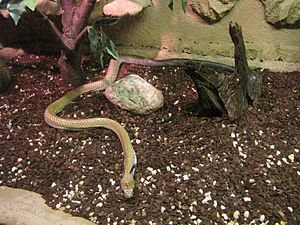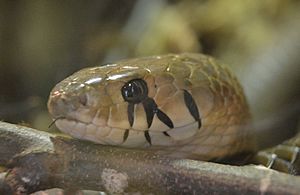Middle American indigo snake facts for kids
Quick facts for kids Middle American indigo snake |
|
|---|---|
 |
|
| Drymarchon melanurus | |
 |
|
| Conservation status | |
| Scientific classification | |
| Genus: |
Drymarchon
|
| Species: |
melanurus
|
| Subspecies | |
|
Five, see text. |
|
| Synonyms | |
|
|
The Middle American indigo snake (Drymarchon melanurus), also called the blacktail cribo, is a type of very large snake. It is not venomous, meaning it doesn't have poison. This snake belongs to the Colubridae family. You can find this snake only in certain parts of the world. It lives in the southwestern United States, Mexico, Central America, and northern South America. There are five different kinds, or subspecies, of this snake. One of them is the Texas indigo snake.
Contents
What Does It Look Like?
The Middle American indigo snake is a really big snake. It can grow to be about 1.8 to 2.4 meters (6 to 8 feet) long. That's longer than most grown-ups are tall!
Its body is mostly a shiny olive-brown color. But as you look towards its tail, the color changes to black. The snake's belly is lighter, usually a yellowish or tan olive color.
This snake has some special dark marks on its head. It has dark spots around its eyes. There's also a dark line right behind its jaw. And you can see a thick dark line going across both sides of its neck.
One of the subspecies, called D. m. erebennus, is mostly solid black. But even this type can have some lighter shades.
Where Does It Live?
The Middle American indigo snake lives in many places. Its home stretches from southern Texas in the United States. From there, it goes south along the Gulf Coast of Mexico. You can also find it in the Yucatán Peninsula, Guatemala, and Belize.
On the other side of Mexico, along the Pacific coast, it lives from Sinaloa south to Guatemala. Its range continues even further south into Colombia, Venezuela, and Ecuador. These snakes can live from close to sea level up to about 1,900 meters (6,230 feet) high in the mountains.
The D. m. erebennus subspecies, also known as the Texas indigo snake, is found in southern Texas. Its range also goes south into Mexico, as far as Veracruz.
Different Kinds of Middle American Indigo Snakes
There are five different subspecies of the Middle American indigo snake. Each one is a slightly different version of the same snake. Here are the recognized subspecies:
- Drymarchon melanurus erebennus (named by Cope in 1860)
- Drymarchon melanurus melanurus (named by A.M.C. Dumeril, Bibron & A.H.A. Dumeril in 1854)
- Drymarchon melanurus orizabensis (named by Dugès in 1905)
- Drymarchon melanurus rubidus (named by H.M. Smith in 1941)
- Drymarchon melanurus unicolor (named by H.M. Smith in 1941)
If you see a name in parentheses after a subspecies, it means that snake was first described under a different scientific group (genus) than Drymarchon.
See also
 In Spanish: Culebra arroyera de cola negra para niños
In Spanish: Culebra arroyera de cola negra para niños


